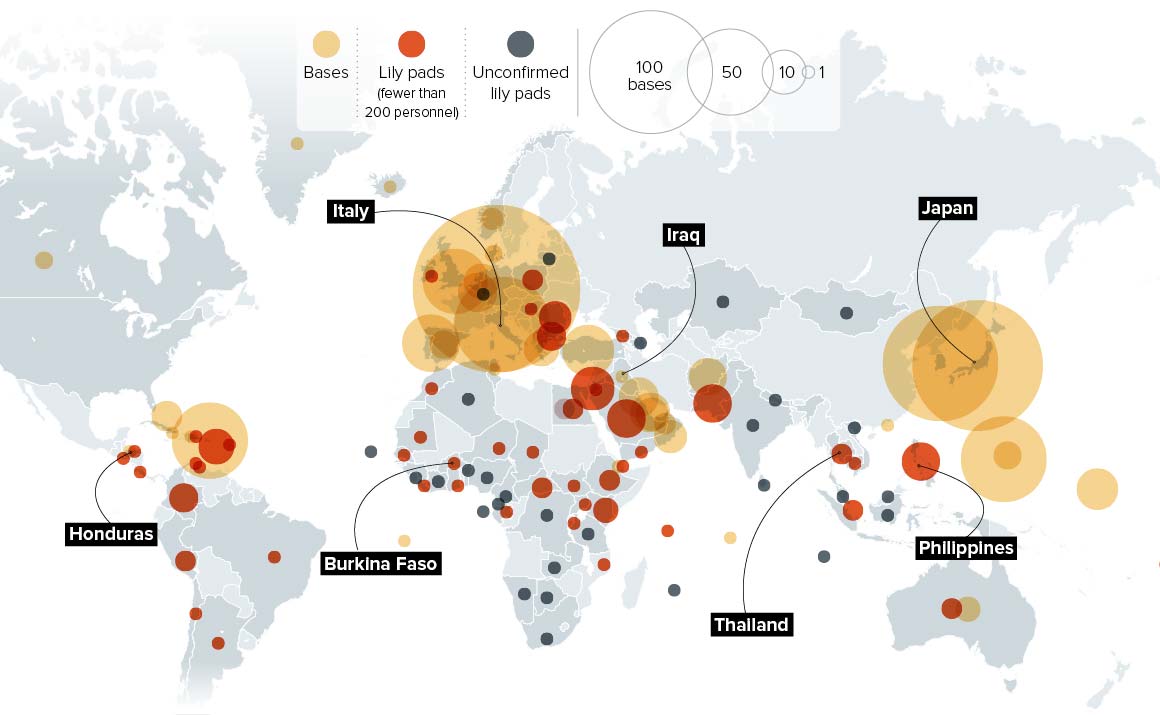An Anthropologist looks at U.S. forts, bases, lily-pads – endless wars and first strikes
Thursday, October 7th, 2021The United States of War, David Vine, 2020
The U.S. military has waged war, engaged in combat, or otherwise employed its forces aggressively in foreign lands in all but eleven years of its existence.
Rather than being a book about battles, this book uses military bases as windows to understand the pattern of endless U.S. wars…These bases have expanded the boundaries of the United States, while keeping the country locked in a state of nearly continuous war that has largely served the economic and political interests of elites and left tens of millions dead, wounded, and displaced.
Beyond a way of warfare, this mode of total genocidal war (against native Americans) became important to the development of a distinct U.S. identity. This identity in turn has played some role in shaping later wars and the conduct of those wars, especially against peoples deemed to be supposedly racially inferior. “Successive generations of Americans, both soldiers and civilians, made the killing of Indian men, women, and children a defining element of their military tradition, and thereby part of a shared American identity.”
By the end of World War II…the United States would build and occupy some thirty thousand installations at two thousand base sites worldwide. While large numbers of bases would close at War’s end what remained was a global base network larger than any in human history…By war’s end, Roosevelt would oversee the largest expansion of bases, territory, and imperial power in U.S. History – arguably far exceeding the power of Jefferson’s purchase (Louisiana Territory).
Other “territories” (excepting the Philippines which was granted independence in 1946) remained colonies without democratic incorporated into the United States. They included Hawaii, Alaska, Puerto Rico, the U.S. Virgin Islands, Guam, American Samoa, Guantanamo Bay, and the Panama Canal Zone.
U.S. officials further used the nation’s unchallenged military superiority at the end of World War II to dictate much of the postwar international economic system, on which geoeconomic power would be based. New global institutions such as the World Bank, the International Monetary Fund, and the United Nations became important economic and political tools to open and dominate markets and maintain other countries in subordinate relationships.
“The United States did not abandon empire after the Second World War. Rather it reshuffled its imperial portfolio,…investing in military bases, tiny specks of semi-sovereignty strewn around the globe.”
Across history and geography the Chagossians and others displaced by U.S. Bases abroad are thus linked along a continuum of violence to the victims of war in Southeast Asia, Iraq, and Afghanistan; to Native American peoples displaced, dispossessed, and murdered; to Angolans and Mozambicans kept under Portuguese colonial rule for decades with U.S. Aid exchanged for Azores basing rights; to Indonesians slaughtered in a U.S. Supported genocide; to Cubans and Haitians and many others killed during dozens of U.S. Invasions in Latin America; to Guatemalans and Chileans tortured, assassinated, and disappeared during U.S. Based coups; to the enslavement, murder, and disenfranchisement of African-Americans over centuries; to attacks on immigrants and religious and sexual minorities in the United States; and to the poor in the United States whose bodies are so often ground up by the workings of everyday capitalism and the U.S. Wars they are so often sent to fight.

